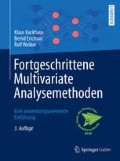Zusammenfassung
Bei vielen Fragestellungen im praktischen und wissenschaftlichen Bereich geht es darum, kausale Abhängigkeiten zwischen bestimmten Merkmalen (Variablen) zu untersuchen. Werden mit Hilfe eines Datensatzes Kausalitäten überprüft, so wird allgemein von einer Kausalanalyse gesprochen. Im Rahmen der Kausalanalyse ist es von besonderer Wichtigkeit, dass der Anwender vor Anwendung des statistischen Verfahrens intensive sachlogische Überlegungen über die Beziehungen zwischen den Variablen anstellt. Auf Basis eines theoretisch fundierten Hypothesensystems wird dann mit Hilfe der Strukturgleichungsanalyse überprüft, ob die theoretisch aufgestellten Beziehungen mit dem empirisch gewonnenen Datenmaterial übereinstimmen.
Access this chapter
Tax calculation will be finalised at checkout
Purchases are for personal use only
Preview
Unable to display preview. Download preview PDF.
Literaturhinweise
A. Basisliteratur zur Strukturgleichungsanalyse (Kausalanalyse)
Bollen, K. A. (1989), Structural Equations with Latent Variables, New York u. a.
Byrne, B. M. (2010), Structural equation modeling with AMOS: Basic concepts, applications and programming, 2. Auflage, New York.
Hair, J./ Black, W./ Babin, B./ Anderson, R. (2010), Multivariate Data Analysis, 7. Auflage, Englewood Cliffs (N. J.), Kapitel11 und 12.
Hildebrandt, L./ Homburg, C. (1998), Die Kausalanalyse: Instrument der empirischen betriebswirtschaftlichen Forschung, Stuttgart.
Homburg, C./ Pflesser, C./ Klarmann, M. (2008), Strukturgleichungsmodelle mit latenten Variablen: Kausalanalyse, in: Herrmann, A./ Homburg, C./ Klarmann, M. (Hrsg.): Handbuch Marktforschung, 3. Auflage, Wiesbaden, S. 547–577.
Kaplan, D. (2009), Structural equation modeling – Foundations and extensions, 2. Auflage, Los Angeles.
Reinecke, J. (2005), Strukturgleichungsmodelle in den Sozialwissenschaften, München u. a.
Weiber, R./ Mühlhaus, D. (2014), Strukturgleichungsmodellierung – Eine anwendungsorientierte Einführung in die Kausalanalyse mit Hilfe von AMOS, SmartPLS und SPSS, 2. Auflage, Berlin / Heidelberg.
B. Zitierte Literatur
Arbuckle, J. L. (2013), IBM SPSS Amos 22 User's Guide, Chicago.
Backhaus, K./ Blechschmidt, B./ Eisenbeiß, M. (2006), Der Stichprobeneinfluss bei Kausalanalysen, in: Die Betriebswirtschajt, Vol. 66, Nr. 6, S. 711–726.
Bagozzi, R. (1980), The Nature and Causes of Self Esteem, Performance and Satisfaction in the Sales Force: A Structural Equation Approach, in: Journal of Business, Vol. 53, S. 315–331.
Bearden, W./ Sharma, S./ Teel, J. (1982), Sample Size Effects on Chi Square and Other Statistics Used in Evaluating Causal Models, in: Journal of Marketing Research, Vol. 19, S. 425–430.
Blalock, H. (Hrsg.) (1985), Causal models in the social sciences, Band 2, Chicago.
Bliemel, F./ Eggert, A./ Fassot, G./ Henseler, J. (2005), Handbuch PLSPfadmodellierung: Methode, Anwendung, Praxisbeispiele, Stuttgart.
Boomsma, A. (1982), The Robustness of LISREL against Small Sample Sizes in Factor Analysis Models, in: Jöreskog, K./Wold, H. (Hrsg.), Systems under indirect observations, Amsterdam/ New York/ Oxford, S. 149–173.
Browne, M. W./ Cudeck, R. (1993), Alternative Ways of Assessing Equation Model Fit, in: Bollen, K. A./ Long, J. S. (Hrsg.): Testing Structural Equation Models, Newbury Park, S. 136–162.
Browne, M. (1982), Covariance structures, in: Hawkins, D. (Hrsg.), Topics in applied multivariate analysis, S. 72–141, Cambridge.
Browne, M. (1984), Asymptotically distribution-free methods for the analysis of covariance structures, in: British Journal of Mathematical and Statistical Psychology, Vol. 37, S. 62–83.
Hair, J. F./ Hult, T. M./ Ringle, C. M./ Sarstedt, M. (2013), A Primer on Partial Least Squares Structural Equation Modeling (PLS-SEM), Thousand Oaks.
Hildebrandt, L. (1983), Konfirmatorische Analysen von Modellen des Konsumentenverhaltens, Berlin.
Hildebrandt, L. (1984), Kausalanalytische Validierung in der Marketingforschung, in: Marketing ZFP, Vol. 1, S. 41–51.
Homburg, C./ Baumgartner, H. (1995), Beurteilung von Kausalmodellen, in: Marketing ZFP, Vol. 17, S. 162–176.
Homburg, C./ Klarmann, M./ Pflesser, C. (2008), Konfirmatorische Faktorenanalyse, in: Herrmann, A./ Homburg, C./ Klarmann, M. (Hrsg.): Handbuch Marktforschung, 3. Auflage, Wiesbaden, S. 271–303.
Homburg, C./ Sütterlein, S. (1990), Kausalmodell in der Marketingforschung EQS als Alternative zu LISREL 7? in: Marketing ZFP, Vol. 12, Nr. 3, S. 181 ff.
Hu, L.-T./ Bentler, P. (1999), Cutoff Criteria for Fit Indexes in Covariance Structure Analysis: Conventional Criteria Versus New Alternatives, in: Structural Equation Modelling, Vol. 6, S. 1–55.
Huber, F./ Herrmann, A./ Meyer, F./ Vogel, J./ Vollhardt, K. (2007), Kausalmodellierung mit Partial Least Squares, Wiesbaden.
Noonan, R./ Wold, H. (1977), Nipals path modelling with latent variables: Analysing school survey data using Nonlinear Iterative Partial Least Squares, in: Scandinavian Journal of Educational Research, Vol. 21, S. 33 ff.
Opp, K.-D./ Schmidt, P. (1976), Einführung in die Mehrvariablenanalyse, Hamburg.
Pohl, A. (2004), Preiszufriedenheit bei Innovationen – Eine nachfragerorientierte Analyse am Beispiel der Tourismus- und Airlinebranche, Wiesbaden.
Ringle, G. M./ Wende, S./ Will, A. (2005), SmartPLS, Release 2.0 (beta), Hamburg.
Scholderer, J./ Balderjahn, I. (2006), Was unterscheidet harte und weiche Strukturgleichungsmodelle nun wirklich? in: Marketing ZFP, Vol. 28, Nr. 1, S. 57–70.
Weiher, R./Adler, J. (2002), Hemmnisfaktoren im Electronic Business: Ansatzpunkte einer theoretischen Systematisierung und empirische Evidenz, in: Marketing ZFP-Spezialausgabe "E-Marketing", Vol. 24, S. 5–17.
Weiher, R./Hörstrup, R./Mühlhaus, D. (2011), Akzeptanz anbieterseitiger Integration in die Alltagsprozesse der Konsumenten: Erste empirische Ergebnisse, in: Zeitung fur Betriebswirtschajt, Sonderhejt Kundenintegration 2.0, Vol. 81, Nr. 5, S. 111–145.
Weiher, R./Mühlhaus, D. (2014), Strukturgleichungsmodellierung Eine anwendungsorientierte Einflihrung in die Kausalanalyse mit Hilfe von AMOS, SmartPLS und SPSS, 2. Auflage, Berlin / Heidelberg.
Author information
Authors and Affiliations
Corresponding author
Rights and permissions
Copyright information
© 2015 Springer-Verlag Berlin Heidelberg
About this chapter
Cite this chapter
Backhaus, K., Erichson, B., Weiber, R. (2015). Strukturgleichungsanalyse. In: Fortgeschrittene Multivariate Analysemethoden. Springer Gabler, Berlin, Heidelberg. https://doi.org/10.1007/978-3-662-46087-0_3
Download citation
DOI: https://doi.org/10.1007/978-3-662-46087-0_3
Published:
Publisher Name: Springer Gabler, Berlin, Heidelberg
Print ISBN: 978-3-662-46086-3
Online ISBN: 978-3-662-46087-0
eBook Packages: Business and Economics (German Language)

